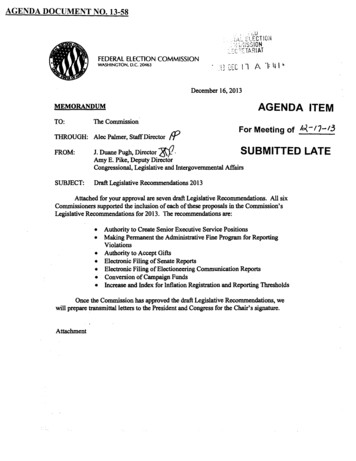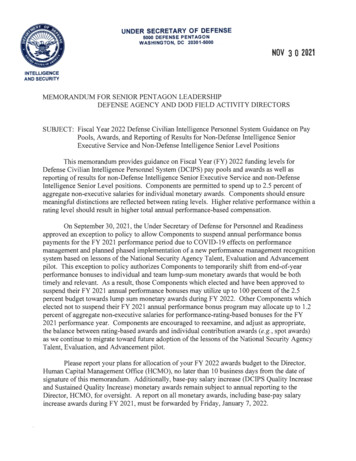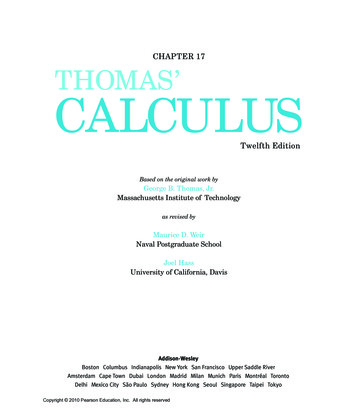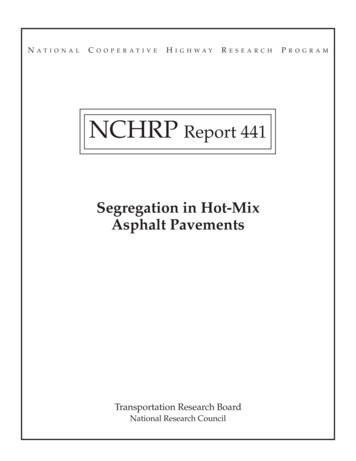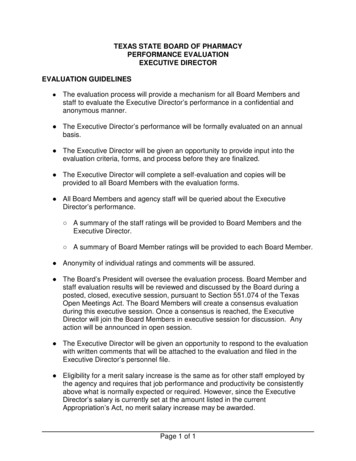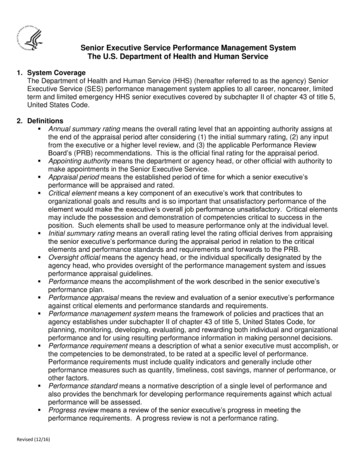
Transcription
Senior Executive Service Performance Management SystemThe U.S. Department of Health and Human Service1. System CoverageThe Department of Health and Human Service (HHS) (hereafter referred to as the agency) SeniorExecutive Service (SES) performance management system applies to all career, noncareer, limitedterm and limited emergency HHS senior executives covered by subchapter II of chapter 43 of title 5,United States Code.2. Definitions Annual summary rating means the overall rating level that an appointing authority assigns atthe end of the appraisal period after considering (1) the initial summary rating, (2) any inputfrom the executive or a higher level review, and (3) the applicable Performance ReviewBoard’s (PRB) recommendations. This is the official final rating for the appraisal period. Appointing authority means the department or agency head, or other official with authority tomake appointments in the Senior Executive Service. Appraisal period means the established period of time for which a senior executive’sperformance will be appraised and rated. Critical element means a key component of an executive’s work that contributes toorganizational goals and results and is so important that unsatisfactory performance of theelement would make the executive’s overall job performance unsatisfactory. Critical elementsmay include the possession and demonstration of competencies critical to success in theposition. Such elements shall be used to measure performance only at the individual level. Initial summary rating means an overall rating level the rating official derives from appraisingthe senior executive’s performance during the appraisal period in relation to the criticalelements and performance standards and requirements and forwards to the PRB. Oversight official means the agency head, or the individual specifically designated by theagency head, who provides oversight of the performance management system and issuesperformance appraisal guidelines. Performance means the accomplishment of the work described in the senior executive’sperformance plan. Performance appraisal means the review and evaluation of a senior executive’s performanceagainst critical elements and performance standards and requirements. Performance management system means the framework of policies and practices that anagency establishes under subchapter II of chapter 43 of title 5, United States Code, forplanning, monitoring, developing, evaluating, and rewarding both individual and organizationalperformance and for using resulting performance information in making personnel decisions. Performance requirement means a description of what a senior executive must accomplish, orthe competencies to be demonstrated, to be rated at a specific level of performance.Performance requirements must include quality indicators and generally include otherperformance measures such as quantity, timeliness, cost savings, manner of performance, orother factors. Performance standard means a normative description of a single level of performance andalso provides the benchmark for developing performance requirements against which actualperformance will be assessed. Progress review means a review of the senior executive’s progress in meeting theperformance requirements. A progress review is not a performance rating.Revised (12/16)
Quality indicator means descriptive language that explains how the rating official willdetermine the work product is acceptable. These indicators often are expressed as smaller,verifiable accomplishments (“mini-results”) that must be completed successfully to producethe principal result identified in the performance objective.Senior executive performance plan means the written critical elements and performancerequirements against which performance will be evaluated during the appraisal period byapplying the established performance standards. The plan includes all critical elements,performance standards, and performance requirements, including any specific goals, targets,or other measures established for the senior executive. The performance plan template,included in this performance management system, is the senior executive performance plan.Strategic planning initiatives means agency strategic plans as required by the GPRAModernization Act of 2010, annual performance plans, organizational work plans, and otherrelated initiatives.3. Appraisal Period Appraisal Period. Executives must be appraised at least annually on their performanceagainst their critical elements and performance standards and requirements and an annualsummary rating must be assigned for the relevant period of performance for each year. HHS’Executive performance rating cycle is October 1st through September 30th of each year. Minimum Period. The minimum period of performance that must be completed before aperformance rating can be given is 90 days. Adjusting Appraisal Period. The agency may end an appraisal period at any time after theminimum appraisal period is completed, but only if the agency determines there is anadequate basis on which to appraise and rate the performance of senior executive(s) and theshortened appraisal period promotes the effectiveness of the administration of the appraisalsystem. Transition Period. The agency may not appraise and rate any career executive within 120days after the beginning of a new Presidential administration.4. Summary Performance Levels The system includes five summary performance levels:o Level 5 – Outstanding Achieved Outstanding Results (AO)o Level 4 - Exceeds Fully Successful Achieved More than Expected Results (AM)o Level 3 - Fully Successful Achieved Expected Results (AE)o Level 2 - Minimally Satisfactory Partially Achieved Expected Results (PA)o Level 1 – Unsatisfactory Achieved Unsatisfactory Results (UR)5. Planning Performance: Critical Elements Supervisors must develop performance plans in consultation with the senior executives andcommunicate the plans to them in writing, including through the use of automated systems, on orbefore the beginning of the appraisal period or upon appointment to a new senior executiveposition. Each senior executive performance plan shall include, as a minimum, the following criticalelements and performance requirements:o Critical Element 1 - Leading ChangeDevelops and implements an organizational vision that integrates key organizationaland program goals, priorities, values, and other factors. Assesses and adjusts tochanging situations, implementing innovative solutions to make organizationalimprovements, ranging from incremental improvements to major shifts in direction orapproach, as appropriate. Balances change and continuity; continually strives toimprove service and program performance; creates a work environment that2
encourages creative thinking, collaboration, and transparency; and maintains programfocus, even under adversity.o Critical Element 2 - Leading PeopleDesigns and implements strategies that maximize employee potential, connects theorganization horizontally and vertically, and fosters high ethical standards in meetingthe organization’s vision, mission, and goals. Provides an inclusive workplace thatfosters the development of others to their full potential; allows for full participation by allemployees; facilitates collaboration, cooperation, and teamwork, and supportsconstructive resolution of conflicts. Ensures employee performance plans are alignedwith the organization’s mission and goals, that employees receive constructivefeedback, and that employees are realistically appraised against clearly defined andcommunicated performance standards. Holds employees accountable for appropriatelevels of performance and conduct. Seeks and considers employee input. Recruits,retains, and develops the talent needed to achieve a high quality, diverse workforcethat reflects the nation, with the skills needed to accomplish organizational performanceobjectives while supporting workforce diversity, workplace inclusion, and equalemployment policies and programs.o Critical Element 3 - Business AcumenAssesses, analyzes, acquires, and administers human, financial, material, andinformation resources in a manner that instills public trust and accomplishes theorganization’s mission. Uses technology to enhance processes and decision making.Executes the operating budget; prepares budget requests with justifications; andmanages resources.o Critical Element 4 - Building CoalitionsSolicits and considers feedback from internal and external stakeholders or customers.Coordinates with appropriate parties to maximize input from the widest range ofappropriate stakeholders to facilitate an open exchange of opinion from diverse groupsand strengthen internal and external support. Explains, advocates, and expressesfacts and ideas in a convincing manner and negotiates with individuals and groupsinternally and externally, as appropriate. Develops a professional network with otherorganizations and identifies the internal and external politics that affect the work of theorganization.o Critical Element 5 - Results DrivenThis critical element includes specific performance results expected from the executiveduring the appraisal period, focusing on measurable outcomes from the strategic planor other measurable outputs and outcomes clearly aligned to organizational goals andobjectives. At a minimum, the performance plan will include performance requirementsthat contain measurable results and their quality indicators describing the range ofperformance at Level 3 for each result specified. It is recommended to also establishthe threshold indicators for Levels 5 and 2. Indicators must reflect the same level ofperformance as the respective performance standard contained in section 6. Inaddition to the quality indicators, applicable measures of quantity, timeliness, and/orcost-effectiveness may be included to describe the appropriate level of outcome(s)expected.The Results-Driven critical element must also identify clear, transparent alignment toagency strategic planning initiatives (e.g., relevant agency or organizational3
goals/objectives with cited page numbers from the Strategic Plan, CongressionalBudget Justification/Annual Performance Plan, or other organizational planningdocument) in the designated section for each performance requirement in the ResultsDriven critical element. Executive performance plans must include the Governmentwide SES performance requirementsin critical elements 1 through 4 as written and may include additional agency-specificperformance requirements written as competencies or specific results/commitments/measurableactivities associated with the critical element.Senior executive performance plans must include specific results focused performancerequirements (e.g., outcomes and outputs) that align to agency goal(s) and objective(s) listedunder the Results-Driven element. Performance requirements for the Results Driven elementmust include quality indicators that identify how well work must be performed and describe howthe rating official will know the work is acceptable. Other measures, targets, and timelines maybe included, as appropriateThe performance requirements in the executive performance plan describe performance at theFully Successful level, as established in the Fully Successful performance standard contained insection 6 of this document.Each critical element must be assigned a weight, with the total weights adding to 100 points.o The minimum weight that may be assigned to the Results Driven critical element is 20points.o The minimum weight that may be assigned to any of the other four critical elements is5 points.o No single performance element may be assigned a greater weight than the Results Drivenelement.o The Rating Official and Executive will determine the weight of each critical element duringthe plan development in line with the criteria as stated above.The gaining organization must set performance goals and requirements for any detail ortemporary assignment of 120 days or longer and appraise the performance in writing, includingthrough an automated system. The executive’s rating official will factor this appraisal into theinitial summary rating.6. Planning Performance: Performance Standards for Critical ElementsThe performance standard for each critical element is specified below. Level 5: The executive demonstrates exceptional performance, fostering a climate that sustainsexcellence and optimizes results in the executive’s organization, agency, department orGovernmentwide. This represents the highest level of executive performance, as evidenced bythe extraordinary impact on the achievement of the organization’s mission. The executive is aninspirational leader and is considered a role model by agency leadership, peers, and employees.The executive continually contributes materially to or spearheads agency efforts that address oraccomplish important agency goals, consistently achieves expectations at the highest level ofquality possible, and consistently handles challenges, exceeds targets, and completesassignments ahead of schedule at every step along the way.Performance at this level may be demonstrated in such ways as the following examples:o Overcomes unanticipated barriers or intractable problems by developing creative solutionsthat address program concerns that could adversely affect the organization, agency, orGovernment.4
o Through leadership by example, creates a work environment that fosters creative thinkingand innovation; fosters core process re-engineering; and accomplishment of establishedorganizational performance targets.o Takes the initiative to identify new opportunities for program and policy development andimplementation or seeks more opportunities to contribute to optimizing results; takescalculated risks to accomplish organizational objectives with positive results.o Accomplishes objectives even under demands and time pressure beyond those typicallyfound in the executive environment.o Achieves results of significant value to the organization, agency, or Government.o Achieves significant efficiencies or cost-savings in program delivery or in daily operationalcosts of the organization. Level 4: The executive demonstrates a very high level of performance beyond that required forsuccessful performance in the executive’s position and scope of responsibilities. The executive isa proven, highly effective leader who builds trust and instills confidence in agency leadership,peers, and employees. The executive consistently exceeds established performanceexpectations, timelines, or targets, as applicable.Performance at this level may be demonstrated in such ways as the following:o Advances progress significantly toward achieving one or more strategic goals.o Demonstrates unusual resourcefulness in dealing with program operations or policychallenges.o Achieves unexpected results that advance the goals and objectives of the organization,agency, or Government. Level 3: The executive demonstrates the high level of performance expected and the executive’sactions and leadership contribute positively toward the achievement of strategic goals andmeaningful results. The executive is an effective, solid, and dependable leader who delivershigh-quality results based on measures of quality, quantity, efficiency, and/or effectiveness, withinagreed upon timelines. The executive meets and sometimes exceeds challenging performanceexpectations established for the position.Performance at this level may be demonstrated in such ways as the following:o Seizes opportunities to address issues and effects change when needed.o Finds solutions to serious problems and champions their adoption.o Designs strategies leading to improvements. Level 2: The executive’s contributions to the organization are acceptable in the short term but donot appreciably advance the organization towards achievement of its goals and objectives. Whilethe executive generally meets established performance expectations, timelines and targets, thereare occasional lapses that impair operations and/or cause concern from management. Whileshowing basic ability to accomplish work through others, the executive may demonstrate limitedability to inspire subordinates to give their best efforts or to marshal those efforts effectively toaddress problems characteristic of the organization and its work. Level 1: In repeated instances, the executive demonstrates performance deficiencies that detractfrom mission goals and objectives. The executive generally is viewed as ineffectual by agencyleadership, peers, or employees. The executive routinely does not meet established performanceexpectations/timelines/targets and fails to produce – or produces unacceptable – work products,services, or outcomes.5
7. Monitoring Performance Monitor and Provide Feedback. Throughout the appraisal period, a supervisor must monitorsenior executive performance in accomplishing elements and requirements and providefeedback, including advice and assistance on improving performance, when needed andencouragement and positive reinforcement as appropriate. Supervisors and senior executivesshould engage in frequent two-way conversations regarding progress toward meeting thecritical elements in the senior executive’s performance plan. Such conversations shouldinclude the following: status updates; identification of obstacles that impede progress inattaining milestones; indicators of success or needs for improvement; and a need to revise thesenior executive’s performance plan to account for changing objectives, priorities and anyother factors affecting the senior executive’s performance toward work assignments orresponsibilities. Progress Review. Each senior executive must receive at least one progress review duringthe appraisal period. At a minimum, the executive must be informed how well he or she isperforming against performance requirements.8. Rating Critical ElementsThe executive will prepare a summary of accomplishments for each critical rating describingtheir overall performance, including metrics and measurable performance results. If the ratingofficial is going to use sub-weights for each performance standard within a critical element thisshould be established in the plan development phase and explained to the executive. Therating official will then consider the executive’s summary of accomplishment for each criticalelement and prepare a narrative justification for rating each critical element in the executive’sperformance plan. The narrative should not repeat the executive’s summary ofaccomplishments or indicate concurrence with the summary of accomplishments. The ratingofficial’s narrative should clearly articulate their justification for the initial summary ratingassigned to each critical element. If individual weights have been assigned within the criticalelement, the rating official will use a mathematical formula for determining the rating at thecritical element level.9. Deriving the Summary Rating Critical Element Point Values. Once the rating for each critical element is determined, thefollowing point values will be assigned to the element ratings: Level 5 Achieved Outstanding Results (AO) 5 points Level 4 Achieved More than Expected Results (AM) 4 points Level 3 Achieved Expected Results (AE) 3 points Level 2 Partially Achieved Expected Results (PA) 2 points Level 1 Achieved Unsatisfactory Results (UR) 0 points Derivation Formula. The derivation formula is calculated as follows:o If any critical element is rated Level 1 (Unsatisfactory), the overall summary rating isUnsatisfactory. If no critical element is rated Level 1 (Unsatisfactory), continue to thenext step.o For each critical element, multiply the element rating level point value by the weightassigned to that element.o Add the results from the previous step for each of the five critical elements to come to atotal score.o Assign the initial summary rating using the ranges below: 475-500 Level 5 400-474 Level 4 300-399 Level 36
200-299 Level 2 Any critical element rated Level 1 Level 1o Example, with the initial summary rating determined to be Level 4 (Exceeds FullySuccessful):Critical Element1. Leading Change2. Leading People3. Business Acumen4. Building Coalitions5. Results DrivenTotal 151540100 pointsInitial PointScore4 x 15 605 x 15 753 x 15 454 x 15 604 x 40 160400Summary Level Range475-500 Level 5400-474 Level 4300-399 Level 3200-299 Level 2Any CE rated Level 1 Level 1Initial Summary Rating. The rating official will develop an initial summary rating in writing,including through the use of automated systems, and share the rating with the seniorexecutive.Opportunity for Written Response. A senior executive may respond in writing, includingthrough the use of automated systems, to the initial summary rating.Opportunity for Higher Level Review (HLR). Upon a senior executive’s request, the agencymust provide an opportunity for review of the initial rating before the rating is presented to thePRB. The agency may designate who will provide HLR for its executives, except that a reviewmay not be provided by a member of the PRB or an official who participated in determiningthe initial summary rating.o When an agency cannot provide a review by a higher-level official because no suchhigher-level official exists in the agency (e.g., the agency head provided the initialsummary rating, the higher-level reviewer position is vacant, etc.), the agency mustoffer an alternative review by an official the agency deems appropriate.An official providing HLR or an alternative review may not change the initial rating but mayrecommend a different rating to the PRB. Copies of findings and recommendations by theHLR official or the official performing an alternative review must be given to the seniorexecutive, the rating official, and the PRB.Forced Distribution. A forced distribution of rating levels is prohibited.Job Changes or Transfers. When a senior executive who has completed the minimumappraisal period changes jobs or transfers to another agency, the supervisor must appraisethe executive’s performance in writing, including through the use of automated systems,before the executive leaves; the appraisal will be given to the executive and forwarded to thegaining agency.Transferred Ratings. When developing an initial summary rating for an executive whotransfers from another agency, a supervisor must consider any applicable ratings andappraisals of the executive’s performance received from the former agency.Extending the Appraisal Period. If the agency cannot prepare an executive’s rating at theend of the appraisal period because the executive has not completed the minimum appraisalperiod or for other reasons, the agency must extend the executive’s appraisal period. Oncethe appropriate conditions are met, the agency will then prepare the annual summary rating.Annual Summary Rating. The annual summary rating must be assigned by the appointingauthority (and may not be delegated to an official who does not have authority to make SESappointments) only after considering the recommendations of the PRB. The annual summary7
rating must be communicated to the executive in writing, including through the use ofautomated systems, normally within 3 months of the end of the appraisal period.10. Performance Review Boards PRB. The agency shall establish one or more PRBs to make written recommendations oneach executive’s annual summary rating, performance-based pay adjustment, andperformance award to the appointing authority. Membership. Each PRB must have 3 or more members selected by the agency head ordesignee(s) in a manner that ensures consistency, stability, and objectivity in SESperformance appraisal. PRB appointments must be published in the Federal Register beforeservice begins. Career Membership. More than one-half of the PRB’s members must be career appointeeswhen considering a career appointee’s appraisal, performance-based pay adjustment, orperformance award. Review Ratings. The PRB must review and evaluate the initial performance appraisal andsummary rating, any senior executive’s response, and any higher-level official’s findings andrecommendations on the initial summary rating or the results of an alternative review. ThePRB may conduct any additional review needed to make written recommendations to theappointing authority on annual summary ratings, performance awards, and performancebased pay adjustments for each senior executive. PRB members may not be involved indeliberations involving their own appraisals, performance-based pay adjustments, andperformance awards. Executive Response. The PRB may not review an initial summary rating to which theexecutive has not been given the opportunity to respond in writing, including through the useof automated systems. Agency/Organizational Performance. The PRB must be provided and take into accountappropriate assessments of the agency/organization’s performance, as communicated by theoversight official through performance appraisal guidelines, when making recommendations.11. Dealing with Poor Performance Performance Actions. The agency must: 1) reassign, transfer or remove from the SeniorExecutive Service a career senior executive who has been assigned a Level 1(Unsatisfactory) final summary rating; 2) remove from the Senior Executive Service anexecutive who has been assigned two final summary ratings at less than Level 3 (i.e., Level 2or a combination of Levels 2 and 1) within a three year period; and 3) remove from the SeniorExecutive Service an executive who receives two Level 1 (Unsatisfactory) final summaryratings within five years. Non-probationary career appointees are removed under proceduresin 5 CFR 359 subpart E. Probationary career appointees are removed under procedures in 5CFR 359 subpart D. (Nothing here shall be interpreted to limit removal of probationary SESemployees as permitted by current regulations.) Guaranteed placement in a non-SESposition will be provided under 5 CFR 359 subpart G when applicable. Appeal Rights. Senior executive performance appraisals and ratings may not be appealed.The executive may file a complaint about any aspect of the rating process the executivebelieves to involve unlawful discrimination (EEOC) or a prohibited personnel practice (Officeof Special Counsel). A career appointee being removed from the SES under 5 U.S.C.3592(a)(2) shall, at least 15 days preceding the date of removal, be entitled, upon request, toan informal hearing before an official designated by the Merit Systems Protection Board.12. Other System Requirements Appraisal Results. Performance appraisals will be used as a basis for adjusting pay,granting awards, retaining and removing senior executives, and making other personnel8
decisions. Performance appraisals also will be a factor in assessing a senior executive’scontinuing development needs.Organizational Assessment and Guidelines. The agency must assess organizationalperformance (overall and with respect to each of its particular missions, components,programs, policy areas, and support functions). The agency also must ensure its assessmentresults and evaluation guidelines based upon them are communicated by the oversight officialto senior executives, rating officials, higher level review officials, PRB members, andappointing authorities at the conclusion of the appraisal period and before completion of theinitial summary ratings so that they may be considered in preparing performance appraisals,ratings and recommendations.Oversight. The agency head or the official designated by the agency head providesorganizational assessments and evaluation guidelines and is responsible to oversee thesystem and to certify: 1) the appraisal process makes meaningful distinctions based onrelative performance; 2) executive ratings take into account assessments of organizationalperformance; and 3) pay adjustments, awards and pay levels based on the results of theappraisal process accurately reflect individual performance and/or contribution to agencyperformance. The responsible official designated to provide evaluation guidelines andoversee the appraisal system must do so for the entire executive agency.Performance Distinctions. Rating officials and PRBs will make meaningful distinctionsbased on relative performance that take into account assessment of the agency’sperformance against relevant program performance measures.Differences in Pay Based on Performance. Differentiation will be evident in the payadjustments, performance awards, and rates of pay separately. Senior executives who havedemonstrated the highest levels of performance will receive the highest annual summaryratings and the largest corresponding performance awards, pay adjustments, and rates ofpay. Pay adjustments and performance awards will be made within 5 months following theend of the applicable appraisal period.13. Training and Evaluation Training. The agency will provide information and training to agency leadership, supervisors,and senior executives on the requirements and operation of the agency’s performancemanagement and pay-for-performance systems. Communication of Results. The agency will communicate annually the distribution ofratings from the previous appraisal period and the average pay increases and awardsassociated with each rating level. Agencies must protect the privacy of the ratings received byindividual senior executives. Evaluation. The agency will periodically evaluate the effectiveness of the performancemanagement system(s) and implement improvements as needed.9
SES Performance Management SystemExecutive Performance PlanPart 1. Consultation. I have reviewed this plan and have been consulted on its development.Executive’s Name (Last, First, MI):Apprai
The Department of Health and Human Service (HHS) (hereafter referred to as the agency) Senior Executive Service (SES) performance management system applies to all career, noncareer, limited term and limited emergency HHS senior executives covered by subchapter II of chapter 43 of title 5, United States Code. 2. Definitions

